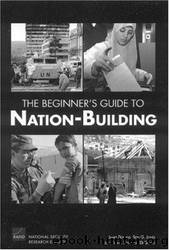The Beginner's Guide to Nation-Building by Dobbins James & Crane Keith & Jones Seth G

Author:Dobbins, James & Crane, Keith & Jones, Seth G. [Dobbins, James & Crane, Keith & Jones, Seth G.]
Language: eng
Format: epub
Tags: This volume presents a comprehensive compilation of best practices in nation-building and serves as an indispensable reference for planning future interventions., International Relations, World, Political Science, Regional Planning, Security (National & International), General, Peace, Public Policy
ISBN: 9780833039880
Google: -XMQOi-orDIC
Publisher: RAND Corporation
Published: 2007-01-15T14:57:48.296026+00:00
of equipment,
⢠Institutional
population
pharmaceuticals,
development and
suffering from
and other
reform of ministry
malnutrition
material delivered
of health
RAND MG557-5.2
12 See, for example, United Nations Development Group and World Bank (2005).
132 The Beginnerâs Guide to Nation-Building
targets, and they must be prioritized to offer sequenced strategic direc-
tion. Fourth, performance metrics should guide policy actions and
donor interventions across all areas where lack of progress carries
the risk of reversing recoveryâfrom political and security issues to the
economy and health. Fifth, indicators should get sufficient donor buy-
in to translate promises into financial commitments, disbursements,
and priority technical assistance. This type of buy-in may help to avoid
the fragmentation of donor assistance and its associated inefficiencies.
Key Actors
At least three major groups of actors should be involved in humani-
tarian efforts: major international organizations, NGOs, and donor
states.
The first group includes large international organizations, espe-
cially those within the United Nationsâ family of agencies. The United
Nations has a number of a organizations that play critical roles in
humanitarian assistance: UNICEF (United Nations Childrenâs Fund),
UNHCR, the World Health Organization, the World Food Pro-
gramme, and the Office of the Coordinator for Humanitarian Affairs.
Some tackle specific problems, such as the distribution of food or
other provisions for refugees. Others, like UNICEF, focus on a spe-
cific group, in this case children. In Kosovo, all humanitarian activities
were put under the direction of a Deputy Special Representative of the
UN Secretary-General who was nominated by UNHCR. This indi-
vidual was able to bring to bear the resources of his own organization
and had the authority to coordinate the efforts of other UN, national,
and nongovernmental agencies. This model worked well and should be
emulated where possible.
Many NGOs specialize in specific areas of humanitarian relief,
such as providing emergency medical care, delivering food or water, or
setting up camps. NGOs range from large international organizations,
such as the International Federation of Red Cross and Red Crescent
Societies, to much smaller organizations. NGOs often have very spe-
cific knowledge about the country or region of concern. At the same
Humanitarian Relief 133
time, NGOs can also pose challenges. The rising number of NGOs has
created coordination problems. As noted earlier, these problems create
a strong impetus to establish institutional arrangements that increase
efficiency and help overcome coordination and collaboration problems.
NGOs may also have a wide range of goals and approaches that differ
from those of the local government, major international organizations,
other NGOs, and donors. Most highly experienced NGOs are part
of networks, such as InterAction, an alliance of U.S.-based NGOs, or
the International Council for Volunteer Agencies. Membership is often
overlapping, and these networks comprise the primary actors in any
emergency. They have established standards and membership criteria
and have been the drivers in many of the key performance initiatives.
Several U.S. government entities are involved in humanitarian
efforts, including USAID; the Bureau of Population, Refugees, and
Migration at the U.S. Department of State; and Department of Defense
forces involved in humanitarian assistance and stabilization efforts.
Donor statesâ goals and policies may be driven by political and geostra-
tegic considerations rather than strictly by considerations of need. The
pursuit of these goals may sometimes result in programs at variance
with best practices viewed from a purely humanitarian perspective.
Costs
To assess humanitarian costs, we examined the per capita relief costs
in the first year of four nation-building operations: Afghanistan, Sierra
Leone, Haiti, and Liberia.
Download
This site does not store any files on its server. We only index and link to content provided by other sites. Please contact the content providers to delete copyright contents if any and email us, we'll remove relevant links or contents immediately.
The Secret History by Donna Tartt(18860)
The Social Justice Warrior Handbook by Lisa De Pasquale(12143)
Thirteen Reasons Why by Jay Asher(8800)
This Is How You Lose Her by Junot Diaz(6802)
Weapons of Math Destruction by Cathy O'Neil(6152)
Zero to One by Peter Thiel(5692)
Beartown by Fredrik Backman(5609)
The Myth of the Strong Leader by Archie Brown(5429)
The Fire Next Time by James Baldwin(5252)
How Democracies Die by Steven Levitsky & Daniel Ziblatt(5133)
Promise Me, Dad by Joe Biden(5088)
Stone's Rules by Roger Stone(5027)
A Higher Loyalty: Truth, Lies, and Leadership by James Comey(4851)
100 Deadly Skills by Clint Emerson(4845)
Rise and Kill First by Ronen Bergman(4705)
Secrecy World by Jake Bernstein(4652)
The David Icke Guide to the Global Conspiracy (and how to end it) by David Icke(4629)
The Farm by Tom Rob Smith(4442)
The Doomsday Machine by Daniel Ellsberg(4420)
